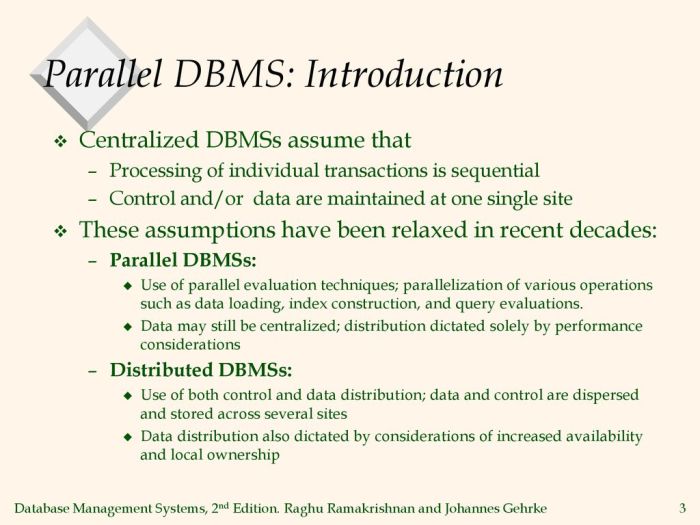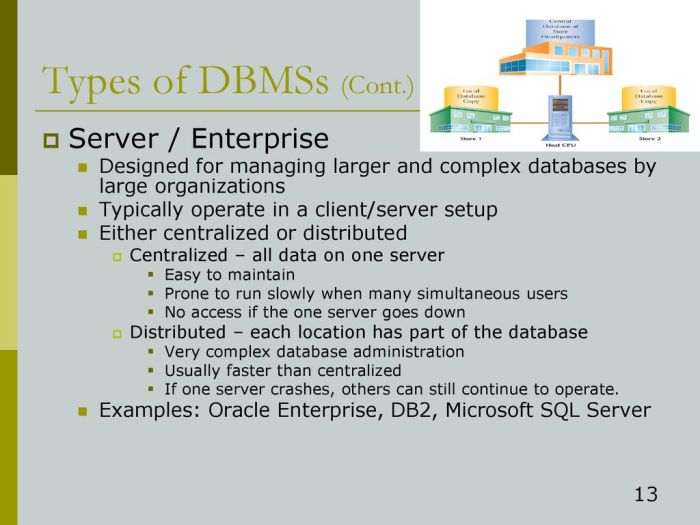Describe the evolution from centralized dbmss to distributed dbmss – The evolution of database management systems (DBMSs) from centralized to distributed architectures has revolutionized data management and processing. This transition has been driven by the increasing demand for data scalability, flexibility, and resilience in modern applications. In this discussion, we will delve into the key differences between centralized and distributed DBMSs, explore the factors that led to this evolution, and discuss the challenges and benefits associated with migrating to distributed systems.
Centralized DBMSs

Centralized database management systems (DBMSs) store all data in a single location, typically on a single server. This makes it easy to manage and control the data, as there is only one point of access.
Advantages of Centralized DBMSs, Describe the evolution from centralized dbmss to distributed dbmss
- Simplicity: Centralized DBMSs are relatively easy to set up and manage.
- Performance: Centralized DBMSs can provide high performance, as all data is stored in one place.
- Data integrity: Centralized DBMSs can ensure data integrity, as all data is controlled by a single authority.
Disadvantages of Centralized DBMSs
- Scalability: Centralized DBMSs can be difficult to scale, as they can become overloaded if too much data is added.
- Availability: Centralized DBMSs can be unavailable if the server fails.
- Cost: Centralized DBMSs can be expensive to set up and maintain.
Examples of Popular Centralized DBMSs
- Oracle Database
- Microsoft SQL Server
- IBM Db2
Distributed DBMSs

Distributed database management systems (DBMSs) store data across multiple locations, typically on multiple servers. This makes it possible to scale the database to handle large amounts of data and to improve availability.
Advantages of Distributed DBMSs
- Scalability: Distributed DBMSs can be scaled to handle large amounts of data by adding more servers.
- Availability: Distributed DBMSs are more available than centralized DBMSs, as data is stored in multiple locations.
- Performance: Distributed DBMSs can improve performance by distributing data across multiple servers.
Disadvantages of Distributed DBMSs
- Complexity: Distributed DBMSs are more complex to set up and manage than centralized DBMSs.
- Data integrity: Distributed DBMSs can be more difficult to ensure data integrity, as data is stored in multiple locations.
- Cost: Distributed DBMSs can be more expensive to set up and maintain than centralized DBMSs.
Examples of Popular Distributed DBMSs
- Apache Cassandra
- Apache HBase
- MongoDB
Evolution from Centralized to Distributed DBMSs: Describe The Evolution From Centralized Dbmss To Distributed Dbmss

The evolution from centralized to distributed DBMSs was driven by the need for scalability, availability, and performance. As data volumes grew and applications became more complex, centralized DBMSs were no longer able to meet the demands of businesses.
Factors that Led to the Evolution from Centralized to Distributed DBMSs
- The need for scalability: As data volumes grew, centralized DBMSs became overloaded and could not handle the increased load.
- The need for availability: Centralized DBMSs were not able to provide the high availability that businesses required.
- The need for performance: Centralized DBMSs could not provide the performance that businesses needed to run their applications.
Challenges Involved in Migrating from Centralized to Distributed DBMSs
- Data integrity: Ensuring data integrity is more difficult in a distributed DBMS, as data is stored in multiple locations.
- Performance: Distributing data across multiple servers can impact performance.
- Cost: Migrating to a distributed DBMS can be expensive.
Case Studies of Successful Migrations from Centralized to Distributed DBMSs
- Netflix: Netflix migrated from a centralized DBMS to a distributed DBMS in order to handle the increasing load of data and to improve performance.
- Amazon: Amazon migrated from a centralized DBMS to a distributed DBMS in order to handle the increasing load of data and to improve availability.
- Google: Google migrated from a centralized DBMS to a distributed DBMS in order to handle the increasing load of data and to improve performance.
Future of Distributed DBMSs

The future of distributed DBMSs is bright. Distributed DBMSs are becoming increasingly popular, as businesses realize the benefits of scalability, availability, and performance that they offer.
Emerging Trends and Technologies that Are Shaping the Future of Distributed DBMSs
- Cloud computing: Cloud computing is making it easier to deploy and manage distributed DBMSs.
- Big data: Big data is driving the need for distributed DBMSs, as traditional DBMSs cannot handle the large volumes of data.
- Artificial intelligence (AI): AI is being used to improve the performance and availability of distributed DBMSs.
Examples of How Distributed DBMSs Are Being Used in Innovative Ways
- Netflix: Netflix is using a distributed DBMS to store and manage the data for its streaming service.
- Amazon: Amazon is using a distributed DBMS to store and manage the data for its e-commerce business.
- Google: Google is using a distributed DBMS to store and manage the data for its search engine.
FAQ Compilation
What are the key differences between centralized and distributed DBMSs?
Centralized DBMSs store all data in a single physical location, while distributed DBMSs distribute data across multiple physical locations. Centralized DBMSs offer simplicity and ease of management, while distributed DBMSs provide scalability, flexibility, and improved performance for large-scale data workloads.
What factors led to the evolution from centralized to distributed DBMSs?
The increasing demand for data scalability, flexibility, and resilience in modern applications has driven the evolution towards distributed DBMSs. Centralized DBMSs face limitations in handling large data volumes and complex data workloads, leading to the adoption of distributed architectures that can distribute data across multiple nodes.
What are the challenges involved in migrating from centralized to distributed DBMSs?
Migrating from centralized to distributed DBMSs involves significant challenges, including data partitioning, data consistency, transaction management, and query optimization. Careful planning, data modeling, and performance tuning are essential to ensure a successful migration.